Ozone 101 is the first in a series of explainer videos outlining the fundamentals of popular Earth science topics. Let’s back up to the basics and understand what caused the Ozone Hole, its effects on the planet, and what scientists predict will happen in future decades.
Video Transcript:
Have you ever heard that something called the ozone layer is thinning? Or that your aerosol hairspray is what’s causing it? Or that it leads to more severe sunburns and UV rays? This is referring to the ozone hole.
But what exactly does it all mean? Welcome to ozone 101.
The ozone holes proper name is actually the Antarctic ozone hole because when it forms it forms over Antarctica. But before we get into what that is, let’s first talk about what ozone itself is.
Ozone is a gas comprised of three oxygen atoms, about 90% of the Earth’s ozone exists in the stratosphere, the layer of the atmosphere that extends from eight to about 30 miles above the earth’s surface. In fact, the stratosphere is often referred to as the ozone layer.
Ozone acts as a sunscreen around the Earth filtering out harmful ultraviolet radiation or UV rays, which are mainly absorbed in the stratosphere.
Without an ozone layer, UV radiation would sterilize the Earth with a damaged but still present ozone layer, there will be more sunburns, more skin cancer cases increased cases of eye damage the wilting and loss of trees and plants and significantly lessened crop yields.
Suffice it to say ozone is pretty important for the planet.
So what causes the ozone hole?
There are several major factors that together lead to the destruction of ozone, thus creating the ozone hole.
Those factors are, one, very strong winds around the South Pole, or the polar vortex. Two, the sun’s rays. Three, chlorine and bromine compounds from ozone-depleting substances. And four, cold temperatures below negative 109 degrees Fahrenheit in the stratosphere, which form a specific kind of cloud polar stratospheric clouds.
The polar vortex forms in the southern hemisphere stratospheric during the winter as temperatures drop. And when sunlight returns to Antarctica and late winter and early spring, temperatures are still cold enough to form polar stratospheric clouds. And now there’s also sunlight.
Chemical reactions take place on the cloud particle surfaces, converting unreactive forms of chlorine and bromine into reactive chemicals.
The vortex acts as a sort of container confining the contents of the Antarctic stratosphere within its bounds allowing the reactive chlorine and bromine compounds to destroy ozone molecules.
That’s when depletion can occur on a large scale.
With the presence of sunlight, the reactive chlorine and bromine compounds produced during winter begin to deplete ozone molecules by stealing one of their oxygen atoms, leaving just oxygen gas, or O2, in its wake.
As long as a polar stratospheric clouds are present, these reactions will occur over and over again until the ozone is nearly gone.
This forms what we call the ozone hole. But that’s really a misnomer. It’s actually more of a thinned layer.
In mid to late spring, the vortex begins to break up and the polar air depleted of ozone is mixed back into the rest of the Southern Hemisphere. The ozone “hole” is gone.
Ozone depletion has still occurred. It’s just no longer all concentrated in one small area. It spread around the atmosphere.
So why is the ozone hole bigger and longer-lasting in certain years? Well, it all comes down to weather, just like some winters are colder and longer than others on the Earth’s surface. The same goes for weather in the stratosphere.
If the Antarctic stratosphere stays cold, the polar vortex and the ozone hole within it will persist. And in years with cold springtime temperatures, the polar vortex and the ozone hole are large.
Make no mistake, ozone depletion is not a natural thing. It stems from human emissions of chemicals called chlorofluorocarbons or CFCs.
In the early 1900s refrigerators used toxic gases like ammonia and methyl chloride as refrigerants. Unfortunately, this led to fatalities as the toxic gases leaked out of the appliances.
So the search began for a nontoxic and non-flammable chemical that can be used as a refrigerant. Thus the CFC was born.
There are many types of CFCs but the two most common are CFC 11 and CFC 12. In the 1930s, the production and consumption of CFCs began to skyrocket.
By the early 1980s, over 300 million pounds of CFC 11 alone were being released into the atmosphere each year.
Then, in 1985, British researcher Joe Farman and his colleagues published their research on large seasonal ozone losses over Antarctica. Thanks to the combined efforts of the quick-acting science community industry and policymakers the Montreal Protocol was signed in 1987, restricting the production and consumption of CFCs. Every nation on earth has now signed the Montreal Protocol.
So for the record, your hairspray and aerosol deodorant haven’t been harming ozone since these laws went into effect in the 80s.
But why do we still see an ozone hole today?
First CFCs have lifetimes of 50 to 100 plus years and it will take some time for the concentration of CFCs in the atmosphere to drastically decline.
Second, there are still CFCs being released into the atmosphere today. For example, as an old refrigerator or air conditioning unit deteriorates in a landfill, the CFCs within are slowly released.
From the time a CFC is released into the air, it takes about five years for its impact to be felt over Antarctica, where depletion will occur.
The CFCs emitted at the surface eventually rise into the tropical stratosphere. The ozone in the stratosphere blocks most of the sun’s UV radiation, so the CFCs have to rise above most of the ozone layer before sunlight can then break them down.
Once they get high enough solar radiation releases the chlorine most of which eventually goes into ozone, say forms like hydrochloric acid and chlorine nitrate.
When these compounds make their way to Antarctica, those chemical reactions start up.
And if you’re wondering why Antarctica these reactions are unique to the polar regions, because of their extreme low temperatures, and presence of polar stratospheric clouds.
One chlorine atom can destroy 1000s of ozone molecules, and millions of tons of CFCs were pumped into the atmosphere from the 1920s through the early 1990s.
As CFC concentrations in the atmosphere continue to decline, the ozone hole is expected to gradually become less severe, and scientists expect the Antarctic ozone to recover back to healthy levels around the year 2070.

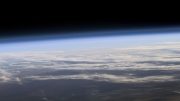
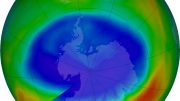
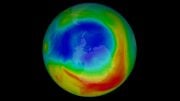

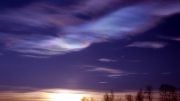
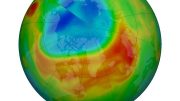
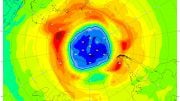
“There are several major factors that together lead to the destruction of ozone, thus creating the ozone hole. Those factors are, one, very strong winds around the South Pole, or the polar vortex.”
That is inaccurate. The circumpolar vortex does NOT destroy ozone. Ozone is metastable, with a relatively short half-life. Most ozone is generated in the stratospheric tropics, and it moves polewards through the Brewer-Dobson circulation cells, replenishing the ozone that decays. However, during the Winter, the ozone generated in the tropics is unable to make it past the barrier created by the circumpolar vortex. Note that in any and all of the depictions of the ‘Ozone Hole,’ there are large regions (typically displayed in yellow and red colors) that represent concentrations much higher than in the Summer, or anytime in the tropics where the ozone originates. It is the lack of new ozone that is partially responsible for the decline in the stratospheric ozone over the South Pole. It is true that photocatalytic destruction occurs in the spring. However, it is sunlight along with very cold temperatures that is responsible for the accelerated destruction. Without the circumpolar vortex, it would not get as cold. The circumpolar vortex is a weather phenomenon that is seasonal, like snow or monsoon rains.
“In mid to late spring, the vortex begins to break up and the polar air depleted of ozone is mixed back into the rest of the Southern Hemisphere. The ozone “hole” is gone.”
That explanation also leaves a lot to be desired for accuracy. Note that in the process of mixing, air with abnormally high concentrations of ozone just outside the vortex is mixed with the air depleted in ozone inside. The net balance of the mixing depends on the volume and concentration of the ozone-enriched and the ozone-depleted air masses, which varies from year to year. At southern mid-latitudes, prior to the Montreal Protocol, there was a slight downward drift in ozone concentrations over consecutive Winters; however, by Summer the concentrations were back to the levels necessary to protect the biosphere. The Winter sunlight was too weak to be of much concern.
Something that is NEVER mentioned is that the sun is never directly overhead the so-called Ozone Hole. When the hole is growing in the Spring, the sun’s rays have a slant-range through a long path in the atmosphere, often passing through those regions of enriched ozone before hitting the ground.
“Ozone acts as a sunscreen around the Earth filtering out harmful ultraviolet radiation or UV rays, which are mainly absorbed in the stratosphere.”
Actually, the stratospheric ozone is quite effective at eliminating UV-C. However, we get sunburns from the remaining UV-B. Going up in the mountains increases the exposure to UV-B, irrespective of the ozone. NASA has oversimplified the situation!
The problem, such as it is, is being exaggerated, either out of ignorance or malice. Either way, it doesn’t speak well of those who are promoting the scary stories.
‘Member when the ozone hole was going to destroy humanity? ‘Member?
Just another hoax that has been proven false by real science. It would be nice if people were actually taught what science is. Or was, as the case may be.
These guys’ comments are on the right track, as opposed to NASA’s politically expedient simplistic propaganda. NASA depends upon someone else’s financial largesse, as do the vast majority of the “scientists” pushing such malarky. They exist at the mercy of Congressional virtue-signalers and those who award grants to follow research which the grantors (Bill and Melinda Gates, the Ford Foundation, the Amazon SMILE Foundation, Natural Resources Defense Council et al).
Ozone (O3) is a naturally unstable form of oxygen, depending upon energy input to disassociate naturally occurring O2 molecules into single oxygen atoms which can temporarily bind to other O2 molecules to form O3. Oxygen’s normal state (absent energy input) is as O2. A steady source of Sunlight is very effect at providing the type of energy necessary to keep Ozone formation high enough to overcome its tendency toward degradation back into O2.
Going back to grade-school geography (as NASA has failed to do), tells us that one of the most common traits of winter at the pole is… lack of sunlight. Is it any wonder that ozone loss is greatest during a time the primary ozone energizer (sunlight) is absent? Or, to approach from a different direction, and since it requires energy to create ozone, what if the ozone is the RESULT of absorbed solar UV ionization?